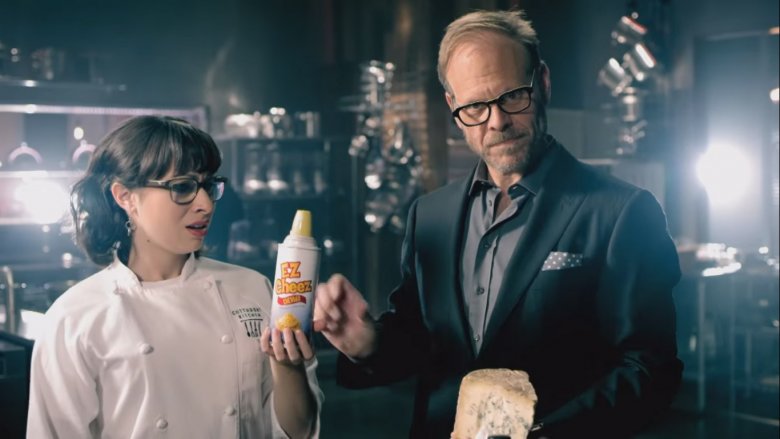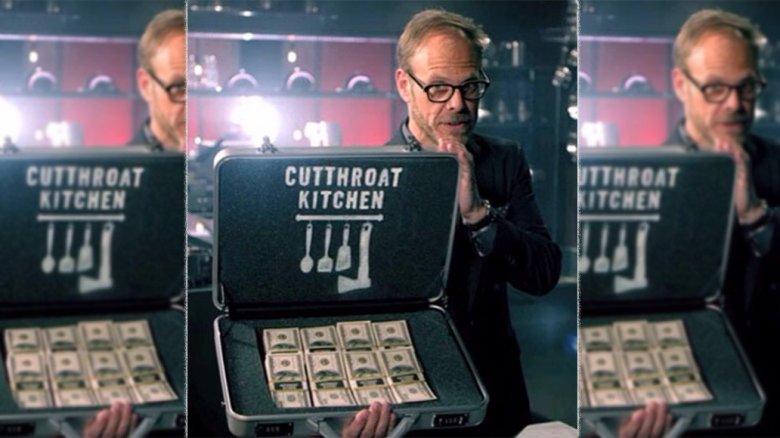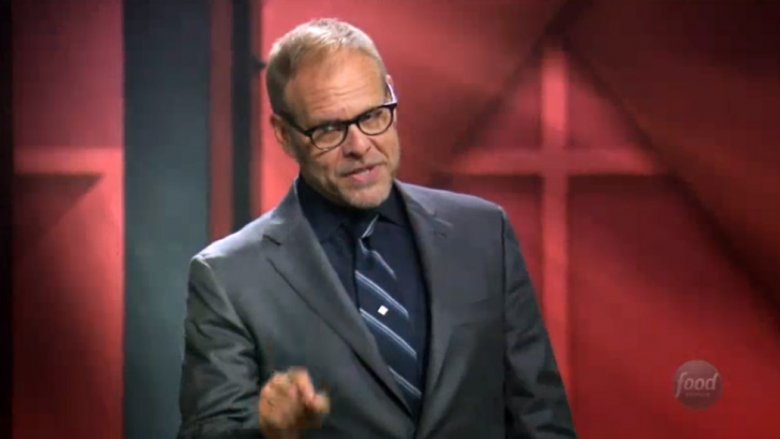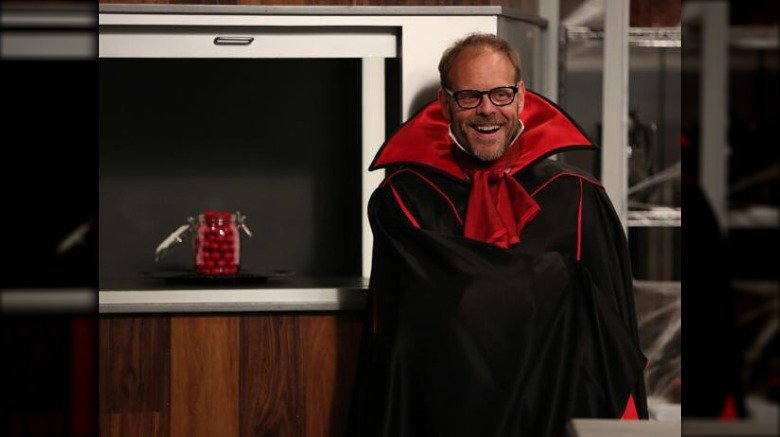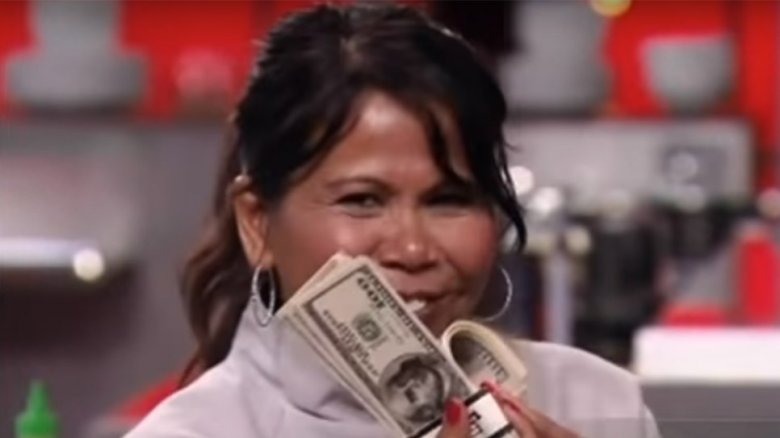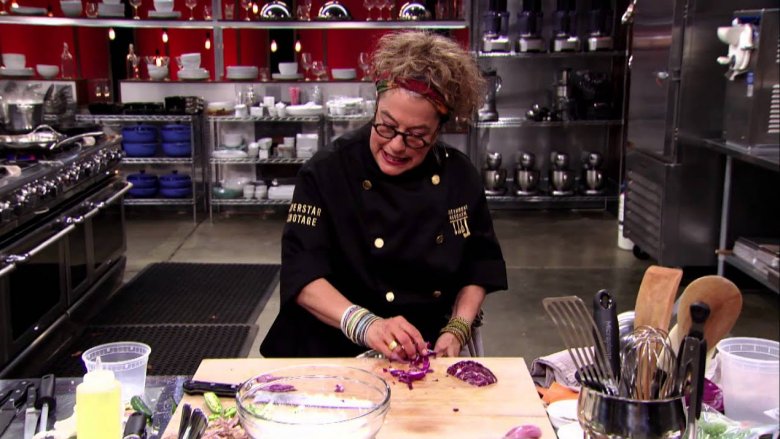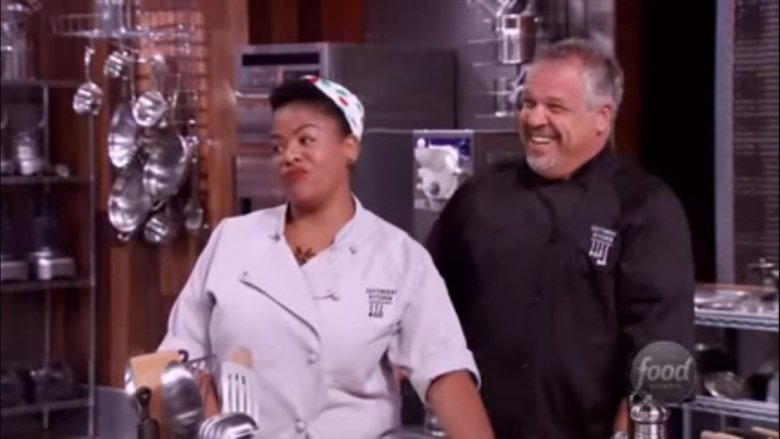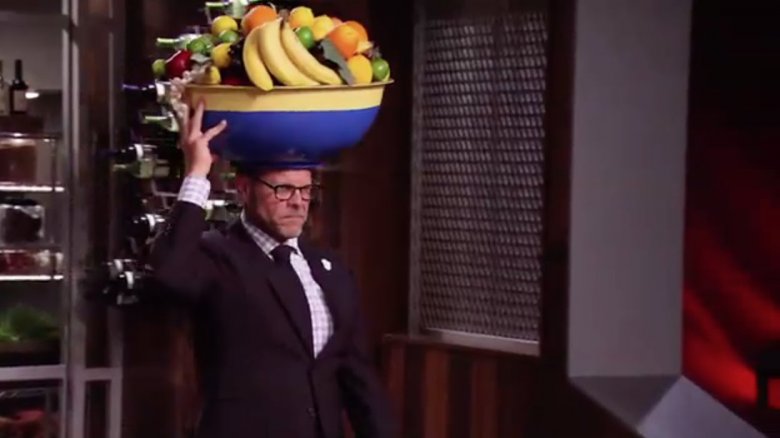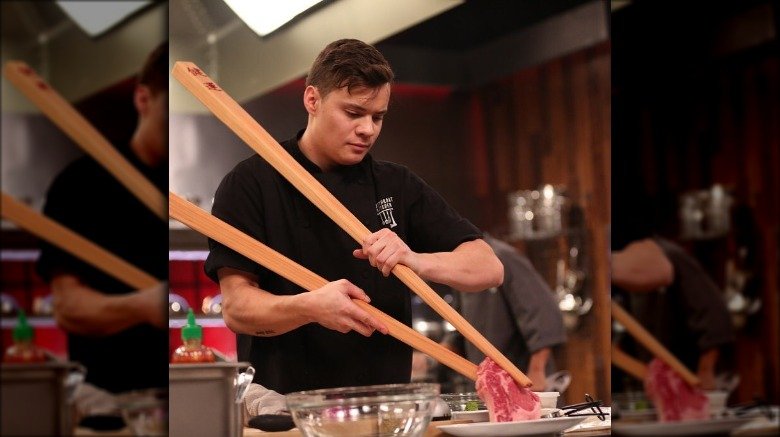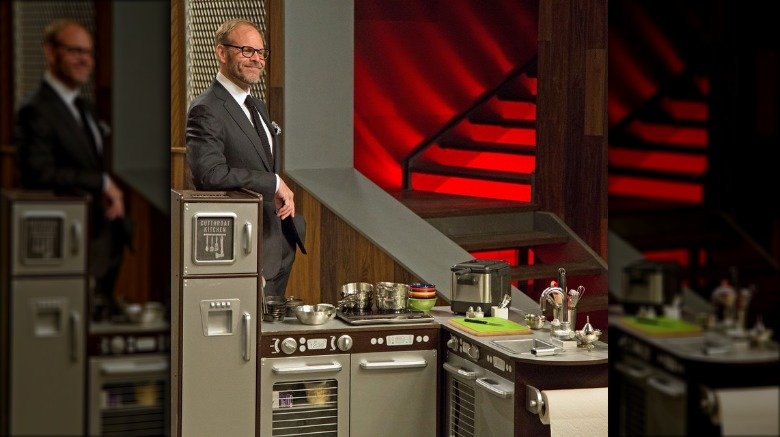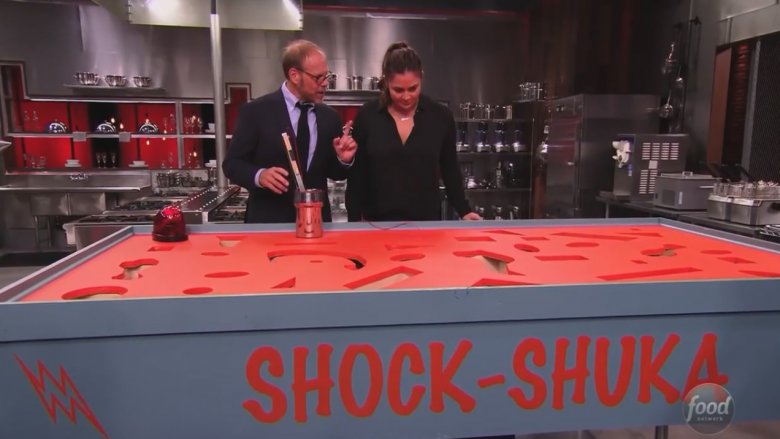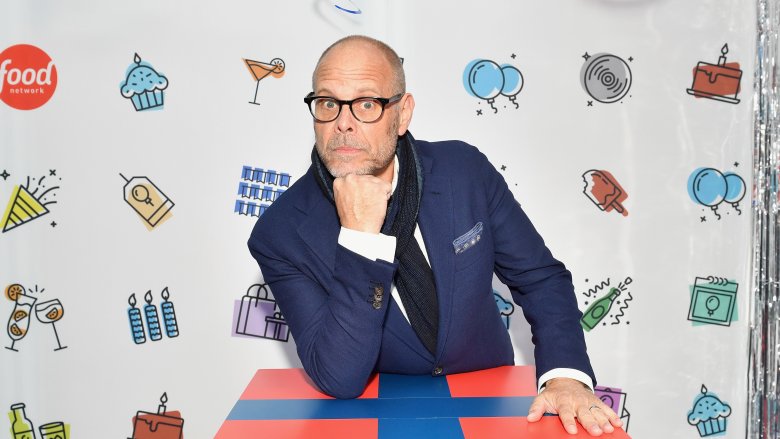The Untold Truth Of Cutthroat Kitchen
Cooking under a strict time limit while TV cameras capture a chef's every mistake has to be difficult. Throw in some ridiculous kitchen sabotages that might require a chef to prepare a meal in a giant ball pit or with toy cooking utensils, and the cooking challenge becomes even more intense. It's exactly those sort of kooky booby traps that make Cutthroat Kitchen a cooking competition unlike any other.
Cutthroat Kitchen certainly has elements of other TV cooking competitions, but it also is a bit of a black sheep. Trash talking is encouraged, the judges have no idea what went into the meal that they're eating, and the chefs competing almost certainly have not cooked under similar conditions before. If there was ever a cooking show that employed a dog-eat-dog mentality, Cutthroat is definitely it. From the pitfalls that can ruin a chef before the cooking even starts to the sabotages that undermine a chef's skills, here's everything you ever wanted to know about this truly twisted show.
The cash in that Cutthroat Kitchen suitcase isn't real
For the Cutthroat Kitchen uninitiated, at the beginning of each episode host Alton Brown walks out with a metal suitcase and opens it up to reveal $100,000 worth of crisp dollar bills. The contestants' eyes light up as he hands them each $25,000 to try to hold onto and use for bidding on tortuous scenarios for their fellow competitors. Everyone is always excited to have a couple stacks of Benjamins in their hands, but the thing is, that cash is totally worthless. Yep, if they were to run out of the studio with it and try to buy something they would come up completely empty-handed because it's not real money.
Whether it's Cutthroat Kitchen, Let's Make a Deal, or some big budget Hollywood crime drama, studios rarely use real money to film with. There's simply too much liability at hand when using real cash, so instead, studios use prop money. Studios take great care to ensure that the prop money doesn't look completely fake on camera, but must still adhere to strict U.S. counterfeit laws.
Even though the cash in the briefcase was fake, the excitement from contestants who won the cash prize was very much real.
The Cutthroat Kitchen concept was born out of another Food Network show
Cutthroat Kitchen didn't have much in common with Good Eats, the show Alton Brown hosted from 1999-2012. The idea behind having chefs try to cook a dish in the middle of the most ridiculous situations possible came about during Brown's time with The Next Iron Chef.
Brown explained that during a few of the Next Iron Chef episodes, they did a series of challenges where certain ingredients would be auctioned off based on how quickly a chef claimed they could cook it. "So if we're bidding on tuna: 'I can cook that tuna in five minutes,' 'I can cook that tuna in four minutes,'" Brown explained. He went on to say that the scenes proved to be incredibly fun for both the chefs and the audience, and this led to discussions of how the auctioning concept could be expanded on its own. "My thing was, the judges shouldn't know what's going on, because then everyone's judged on a level playing field, and that makes the game more fun," Brown said. Of course, what Brown might consider "fun," Cutthroat Kitchen contestants probably considered downright evil.
Cutthroat Kitchen sabotages go through a testing phase to ensure they're even doable
Aside from literally setting a competitor on fire, there seemed to be no limit to the mayhem that chefs inflicted on each other in Cutthroat Kitchen. The challenges lobbed at the chefs are all over the map. They might be as simple as having their ingredients swapped out for gas station condiments, or be as messy as having to search through a giant vat of honey. The one thing that all the challenges have in common, however, is that they must actually be possible before making it onto the show.
"Not only do we test them multiple times to make sure they're doable, but we actually test them in tandem with other sabotages that we might put in the same round," host Alton Brown explained. "We would like for people to be able to survive two sabotages."
Brown said that the Cutthroat team often worked for weeks before a show taping to come up with the challenges and then put them into practice to see if cooking the assigned dish would actually work with the sabotage thrown in the mix. It also wasn't uncommon for sabotages to be so ridiculous that they had to be cut. In fact, Brown said that around 20 percent of the sabotages pitched ended up being just too over-the-top or tricky to pull off and never made it into the show.
Some Cutthroat Kitchen prizes are huge while others are incredibly small
While the contestants on Cutthroat Kitchen all start out with $25,000, bidding wars almost always ensue and most chefs leave with far less than that. That's not to say that there wasn't the occasional chef who managed to survive until the very end and walk out with almost all of their original cash — it just didn't happen often.
Chef Huda, a Washington, D.C.-based chef, appeared on the show in 2014 and made Food Network history when she won her episode ("S'Mortal Combat") and walked away with $23,900. On the other side of the Cutthroat Kitchen coin are the chefs who win but end up bidding away all of their cash, only to leave with a pretty lackluster purse.
Brown explained that it basically boils down to two types of winners: Those with the goal of making bank, and those who simply want to win at all costs. "There are others who come in deciding, 'I'm going to buy this win; I don't care what I walk out with,'" he said before adding, "The lowest anybody's walked out of Cutthroat Kitchen with is $300." Hey, $300 and some reality TV claim to fame still isn't a bad deal.
Only the Cutthroat Kitchen winner gets any sort of compensation
From Hell's Kitchen to Chopped, there's no shortage of TV cooking competitions for chefs who aren't afraid to get in front of the camera and show off their skills. When it comes to Cutthroat Kitchen, though, there are really only two reasons for a chef to appear on the show: bragging rights and the possibility of walking away with up to $25,000. (Alright, maybe some chefs enjoy the abuse, but that's a whole other thing we won't get into.) Some cooking shows pay their contestants, but others only pay the final winner. When it comes to the money, however, Cutthroat Kitchen is a show where the victor and only the victor took all the spoils.
"We were not paid to be on the show as a competitor, however, all travel and expenses were absorbed by the network," Cutthroat veteran Joe Arvin said. Arvin, who appeared on one of the show's Thanksgiving-themed episodes didn't win his episode, but noted that doing the show was still worth his time. "Probably more than anything, I learned to adapt to being on a studio set and in front of the camera," Arvin explained, adding that the media exposure (he also appeared on The Taste and Food Truckers) had been beneficial.
It's called Cutthroat Kitchen — you didn't expect them to give money to everybody, did you?
Most Cutthroat Kitchen contestants are found through social media
Finding people who want to potentially earn $25,000 for a day's work probably isn't that difficult. At least until you tell them they'll be put through the ringer and might walk away with absolute zilch. Chef Joe Arvin said that he was contacted by the show's producers after they stumbled upon his cooking channel on YouTube. "They initially wanted to know how strong of a competitor I was and if I thought that I would be able to handle the pressure of competing on a show like Cutthroat Kitchen," Arvin said.
According to Arvin, it's pretty common for the show's producers to reach out to potential contestants through YouTube or various other social media platforms. Once somebody says they're interested in appearing on the show, they then send in a resume along with a few photographs of their best dishes. From there, contestants have a few Skype calls with the show's producers to discuss their culinary background and if they have the right mindset to keep their cool in the kitchen under pressure.
In total, Arvin said his audition process took around four months and oddly enough, there was never any actual cooking as part of his audition. Maybe producers thought nobody who didn't have legit cooking skills would be crazy enough to subject themselves to Alton Brown's kitchen torture.
Trash talking is encouraged on Cutthroat Kitchen
Competitive cooking shows tend to often fall into one of two categories: supportive and friendly competition or dog-eat-dog bloodbaths. Whereas contestants on a show like Baking Championship or Chopped are typically cordial with one another, contestants on a program such as Hell's Kitchen and Cutthroat think nothing of letting loose with the trash talking.
After all, it might seem a little out of place for contestants on a show with the format and title of Cutthroat Kitchen to be buddy-buddy with one another. Competitor interaction on Cutthroat isn't scripted, but producers definitely try to nudge the chefs in a certain direction. "There is not any 'planned drama' per se, but the producers highly encourage the competitors to bash each other," contestant Joe Arvin said. Billy Ngo, who appeared on season two of the show, said he also was encouraged to engage in some trash talking. Ngo didn't win his episode but did manage a zinger, telling his competitor, "That looks like a TV dinner, bro."
The show even had a lawyer on deck to help ensure that nothing got too crazy and that each episode had a balance of real world versus the Hollywood produced experience. "It's an entertaining show, but it's more of a game show. You can win without being the best chef," noted Ngo.
TV critics didn't show Cutthroat Kitchen a lot of love
Whereas food shows like Top Chef and Mind of a Chef have been lauded with praise by critics, Cutthroat Kitchen never garnered similar accolades. At best, it was called "intriguing" by an Entertainment Weekly critic. Of course, that same critic also advised viewers of how to watch it and keep their "faith in humanity intact." Ouch. The AV Club's review of Cutthroat wasn't much kinder, with critic Phil Dyess-Nugent questioning whether Alton Brown possibly had a twin brother without any sense of shame, saying that the only thing entertaining about the challenges were "the fleeting glimpses of improvisational thinking."
So why so much critical hate for a show that turned the standard cooking competition on its head? Plenty of TV cooking competitions such as Iron Chef, Top Chef, and Chopped have competitors trying to prepare a dish under a time limit using, at times, out of the ordinary ingredients. Cutthroat Kitchen took the premise one step further and injected an element of comedy. The competitors were serious, but the show never took itself too seriously. Perhaps Cutthroat was just too low-brow for foodies.
As one review from Vulture pointed out — and something that too many other critics missed — the real stars of the show weren't necessarily the chefs. What made Cutthroat Kitchen work were the writers, who episode after episode, found a way to take the standard cooking competition and combine it with circus-like absurdity.
Camp Cutthroat borrowed its set from a defunct reality show
Every successful TV cooking competition deserves a spin-off series, right? Cutthroat Kitchen was no different and in 2015 it got its own spin-off with Camp Cutthroat, a version of the show that took chefs out of the studio and put them "in a secret location deep in the wilderness." Rather than simply have Cutthroat newbies, the spin-off series brought in previous competitors and upped the prize money by putting $75,000 on the line.
As for that "secret location" in the middle of the wilderness, well, as viewers noticed pretty quickly, it wasn't exactly uncharted TV territory. Camp Cutthroat was filmed in Santa Clarita, California on the set of a previous Fox reality TV show called Utopia.(Though producers did at least make some slight changes like putting up a new sign at the entrance.) Utopia was described as having elements of the reality show Big Brother, but proved to be far less popular and only lasted 13 episodes. As for Camp Cutthroat, well, perhaps it was just too "extreme" because camp ended for good a year later.
Fans could submit their own sabotage ideas to Cutthroat Kitchen
There seems to be no limit to the zaniness and absurdity of the sabotages on Cutthroat Kitchen. Cooking in a hammock? Sure. Making gnocchi with a potato masher taped to your hand? Yep. The writers of Cutthroat showcased their devilish creativity with each episode and occasionally turned the reins over to the fans when it came to coming up with new sabotages. Because what fan of Cutthroat wouldn't want the chance to make the chefs in the kitchen sweat a little?
"Food Network is currently accepting submissions for upcoming challenges, and it's up to you, Cutthroat fans, to decide with what disruptions future contestants will have to adapt," read the show's website. Fans were invited to submit their ideas either in the comment section or via Twitter with the hashtag #Evilicious.
Who knows how many fan submissions actually made it onto the show, but there were certainly some creative ones thrown out there. One fan suggested strapping a competitor to a Silence of the Lambs-style dolly. Another suggested hiding the clock with only the highest bidder being able to see how much cooking time was left. #Evilicious indeed.
There is definitely some strategy to winning Cutthroat Kitchen
After watching just a handful of Cutthroat Kitchen episodes, it's pretty obvious that there's definitely some strategy to walking away with the cash, besides just being handy with a skillet. One of the biggest pitfalls that way too many chefs fall victim to is bidding too much money up front in the first round.
"While this may help them survive in the short term, their over spending will often come back and bite them in the backside during the latter stages," Cutthroat judge Simon Majumdar explained. "On more than one occasion, I have seen the better chef lose because they had insufficient funds to counter their opponent's bidding in the final round and were sabotaged to defeat."
Poor shopping habits are another thing that can really do a chef in before the bidding or cooking even begins. If a chef is making a cheesecake and forgets cream cheese and sugar they're going to have a real uphill battle. "The No. 1 sabotage is the sabotage the chefs do to themselves in the pantry," Alton Brown said. There's also a high probability that chefs will lose at least some of their ingredients. "Finding alternate acceptable approaches to dishes is always a really good idea," added Brown.
Cutthroat Kitchen judges are kept in the dark until after taping
The whole idea behind Cutthroat Kitchen is to test chefs to find out if they can prepare a dish and still make it taste good while jumping through hoops. It wouldn't be much fun if the judges knew a chef had to make chicken marsala while wearing Mickey Mouse gloves, so the judges have no idea what sabotages unfold during the cooking portion of the show.
"I am locked away, and I can tell you that they are really strict about that," judge Simon Majumdar said. "I go and hide away in my very comfortable trailer, but the guys in makeup don't tell me a thing..." The judges do eventually find out just what sort of kitchen torture the competitors went through — those scenes just aren't in the regular episodes. For the truly dedicated Cutthroat viewer, there was the After-Show web series. In the post-show series, Alton Brown walks the judges through the various sabotages that resulted in both the winning and losing dishes from the contestants. Sometimes the judges themselves even try their hand at cooking with the sabotages in place.
While the judges may not know what the sabotages are, they still want to make sure that cooking through them is possible for the challengers. "I just hope that they keep it to a level where the chefs can still cook," Majumdar said. "Because otherwise, apart from anything else, I still have to eat the stuff."
Cutthroat Kitchen ended its run in 2017
Cutthroat Kitchen had a solid run on TV, and over the course of four years churned out 192 episodes of culinary mayhem. The show is still regularly on TV and various streaming platforms, but the Food Network officially pulled the plug on taping any new episodes. Cutthroat viewers got the bad news from Alton Brown himself when a fan asked the host if there were any new episodes in the works. Brown kept it short and sweet, telling the fan that Cutthroat Kitchen had been cancelled, adding "#probablymyfault."
As to why the Food Network decided to cancel the show, well, it's very likely that Brown simply wanted to do something else. In 2016, the TV show host announced via a video message on Twitter that he would be taking a break from the show to focus his time on a new "internet venture."
So what was that "internet venture" exactly? Well, he did launch Good Eats: Reloaded in 2018, but that appeared on The Cooking Channel... not the internet.
